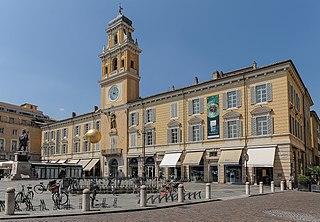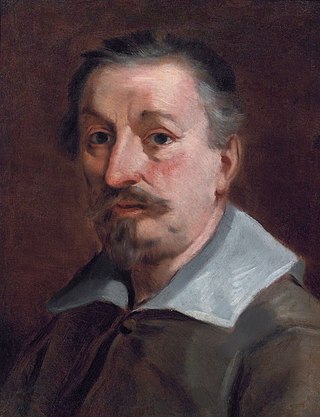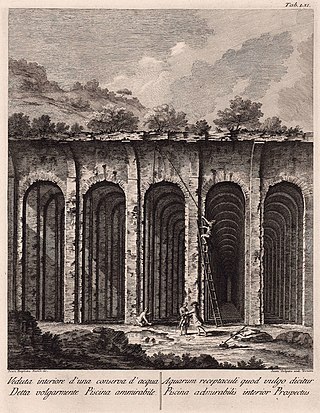
Parma is a city in the northern Italian region of Emilia-Romagna known for its architecture, music, art, prosciutto (ham), cheese and surrounding countryside. With a population of 198,292 inhabitants, Parma is the second most populous city in Emilia-Romagna after Bologna, the region's capital. The city is home to the University of Parma, one of the oldest universities in the world. Parma is divided into two parts by the stream of the same name. The district on the west side of the river is Oltretorrente. Parma's Etruscan name was adapted by Romans to describe the round shield called Parma.

Antonio Allegri da Correggio, usually known as just Correggio was an Italian Renaissance painter who was the foremost painter of the Parma school of the High Renaissance, who was responsible for some of the most vigorous and sensuous works of the sixteenth century. In his use of dynamic composition, illusionistic perspective and dramatic foreshortening, Correggio prefigured the Baroque art of the seventeenth century and the Rococo art of the eighteenth century. He is considered a master of chiaroscuro.

Francesco Albani or Albano was an Italian Baroque painter of Albanian origin who was active in Bologna, Rome, Viterbo (1609–1610), Mantua (1621–1622) and Florence (1633).

Carlo Cignani was an Italian painter. His innovative style referred to as his 'new manner' introduced a reflective, intimate mood of painting and presaged the later pictures of Guido Reni and Guercino, as well as those of Simone Cantarini. This gentle manner marked a break with the more energetic style of earlier Bolognese classicism of the Bolognese School of painting.

Girolamo Francesco Maria Mazzola, also known as Francesco Mazzola or, more commonly, as Parmigianino, was an Italian Mannerist painter and printmaker active in Florence, Rome, Bologna, and his native city of Parma. His work is characterized by a "refined sensuality" and often elongation of forms and includes Vision of Saint Jerome (1527) and the iconic if somewhat anomalous Madonna with the Long Neck (1534), and he remains the best known artist of the first generation whose whole careers fall into the Mannerist period.

Baldassare Franceschini, called Il Volterrano after his birth place Volterra and, to distinguish him from Ricciarelli, Il Volterrano Giuniore was an Italian late Baroque painter and draughtsman active principally around Florence and Volterra. He was mainly known for his frescoes, altarpieces and easel paintings for churches and palaces in Florence, Volterra and Rome. His subject matter was diverse and included portraits, biblical and mythological scenes, history paintings and allegorical compositions.

Lorenzo Lippi was an Italian painter and poet from Florence.

Girolamo Mazzola Bedoli was an Italian painter active in the Mannerist style.

Gregorio de Ferrari was an Italian Baroque painter of the Genoese School.

Filippo Lauri was an Italian painter of the Baroque period, active mainly in Rome.
Giulio Cesare Amidano was an Italian painter of the late-Renaissance style. He was also known as Pomponio Amidano, in part because he is either confused with or was a pupil of Pomponio Allegri; others claim he was a pupil of Francesco Mazzola (Parmigianino). Much of his biography is poorly documented. He is said to have been born in Parma and to have died there from the plague.
The decade of the 1460s in art involved some significant events.

The Shrine of Santa Maria della Steccata is a Greek-cross design Renaissance church in central Parma, Italy. The name derives from the fence in the church. A Nursing Madonna is enshrined within, crowned on 27 May 1601 by a Marian devotee, Fray Giacomo di Forli of the Capuchin order. Pope Benedict XVI raised the Marian sanctuary to the status of Basilica minor on 9 February 2008.

Giovanni Battista Natali, also known as Joan(nes) or Ioannes Baptista Natali, was an Italian painter and draughtsman of the late-Baroque period, active in his natal (?) city of Piacenza,[apparent contradiction] but also Savona, Lucca, and Naples, and finally Genoa in 1736.

Francesco da Cotignola, also called Zaganelli, was an Italian painter of the Renaissance period, active mainly in Parma and Ravenna.

Ireneo Affò was an Italian art historian, writer, numismatist and Franciscan friar.

The Vision of Saint Jerome is a painting by the Italian Mannerist artist Parmigianino, executed in 1526–1527. It is now in the National Gallery, London, United Kingdom.

San Francesco del Prato is a Gothic-style, Roman Catholic church, located on Piazzale San Francesco #4 in central Parma, Italy. In front stands the 15th-century Palazzo Cusani.

Jacopo Loschi or Jacopo d' Ilario Loschi was an Italian painter.

Bernardino Zaganelli, also Bernardino di Bosio Zaganelli and Bernardino da Cotignola, was an Italian painter, of the Renaissance period.


















